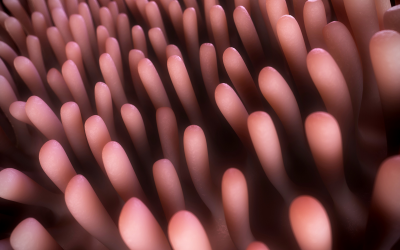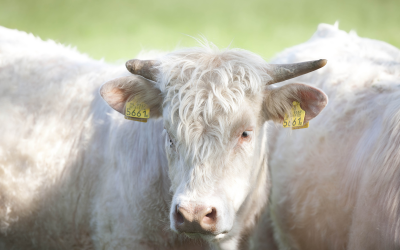Improve gut health by stimulating fibre fermenting bacteria

Increasing the understanding of fibre is presenting new perspectives on the valuable role it can play in gut health and therefore, within performance-enhancing nutritional strategies. Stimulating fibre fermenting bacteria to accelerate the development of a fibre degrading microbiome can play an important role in working toward antibiotic free production and low minerals.
During the IPPE show last year the misconceptions about fibre content being low in monogastric diets was discussed and how fibre can ultimately benefit the host if microbiota can convert it into beneficial metabolites. This year, we evolved this discussion to understand the mechanisms by which the microbiota responds to the inclusion of a new class of functional additive ‘stimbiotic’ to the hosts’ diets.
Organisms and the evolution process
From an evolutionary point of view, we need to remember that simple organisms (bacteria, protozoa and fungi) populated this planet way before us or even other animals. During the evolution process they populated the intestinal environment, which provides the ideal habitats for them. Beneficial bacteria in the hindgut of animals thrive on non-starch polysaccharide (NSP) rich substrates, and in return the products of NSP fermentation – volatile fatty acids – play an important role in gut health and the overall metabolism of the host.
Research suggests that organisms should not be considered on an individual basis, but as a big community or symbionts, as they benefit from each other. This becomes even more important when we see the negative impacts that a sterile intestine can cause to animals, specifically, when we compare germ-free animals to conventional animals. Parker et al. (2018) showed that intestinal function (transit of luminal content, morphology, barrier permeability, mucus production, etc) and immunity can be negatively affected by the lack of intestinal microbiota.
Watch AB Vista’s Global Technical Manager Gilson Gomes summarising his Tech Talk at IPPE 2020 here.
How bacteria communicate
Now we know that fibre fermenting bacteria are beneficial, it is extremely important to identify ways in which we can facilitate the colonisation of the hindgut by these bacteria.
Until recently, very little was known about how bacteria communicate with each-other. Cell-to-cell communication exists between intestinal bacteria, and the bacteria can sense some molecules in the environment, triggering the activation of specific genes. This process is especially well known for virulence expression (Quorum sensing) and for virulence blockage (Quorum quenching).
Grandclément et al. (2016) suggest that bacteria use these mechanisms not only to induce virulence, but also to detect some signal molecules and determine the worthiness to produce extracellular enzymes. This is similar to the sense of smell in animals, which triggers the production of stomach acid and activation of pepsin.
This indicates that xylo-oligosaccharides (XOS), either supplemented directly to the feed or generated in-situ by xylanases supplemented to the feed, will be activating the “diffusion sensing” of fibre fermenting bacteria, or in other words, will be making these bacteria hungry for fibre. Marinho et al. (2007) showed that XOS supplemented to piglets diets increased the activity of xylanase and cellulase in different intestinal segments, while Bedford and Apajalahti (2018) showed that xylanase supplementation to broiler diets made the caecal microbiome specialised to ferment fibre.
Understanding how xylanase behave
One challenge to this mechanism is that, depending on the degree of polymerisation of XOS, we see the subsequent affect upon the microbiota differently. It becomes extremely important to understand the behaviour of the xylanase, or in other words, how efficient the xylanase is to produce small oligosaccharides.
Bautil et al. (2019) showed that 2 commercial xylanases behaved differently by measuring the degree of polymerisation of water extractable arabinoxylans in broilers ileal and caecal content. The research also showed how arabino-xylo-oligosaccharides (AXOS) supplementation made the disappearance of total and water extractable arabinoxylans to be more active in young birds than without the supplementation of AXOS. This demonstrates that these molecules are igniting the fibre fermentation process and making the bacteria more rapidly able to efficiently ferment fibre.
Our research shows that the combination of a specifically selected XOS and xylanase can yield improved performance benefits in poultry and pigs. These further benefits are being caused by the improved stimulation of fibre fermenting bacteria. Signis, our dual action microbiome activator, was created with this concept in mind.
Stimulating fibre fermenting bacteria
Oligosaccharides are usually able to exert a beneficial effect at very low dosages, therefore not considered as a ‘prebiotic’ by definition. This is supported by Ribeiro et al. (2018) who postulated that the addition of 100g/t would equate to less than 0.3 kcal/kg of fermentation products, which does not equate to the performance benefits usually seen when these are supplemented. González-Ortiz et al. (2019) recently hypothesised that any additive that has the ability to stimulate a fibre-degrading microbiome to increase fibre fermentability without becoming the substrate for this microbiome growth should be defined as stimbiotic.
Dietary fibre clearly has more value than what was once thought. Taking into consideration that fibre represents a high proportion of the diet content, it seems unreasonable not to harvest the benefits fibre fermentation can exert. Stimulating fibre fermenting bacteria to accelerate the development of a fibre degrading microbiome can play an important role in working toward antibiotic free production and low minerals, as zinc or copper diets.
For the latest fibre-related news and research, visit our International Fibre Summit website
Author: Gilson Gomes, Head of Global Technical, AB Vista






